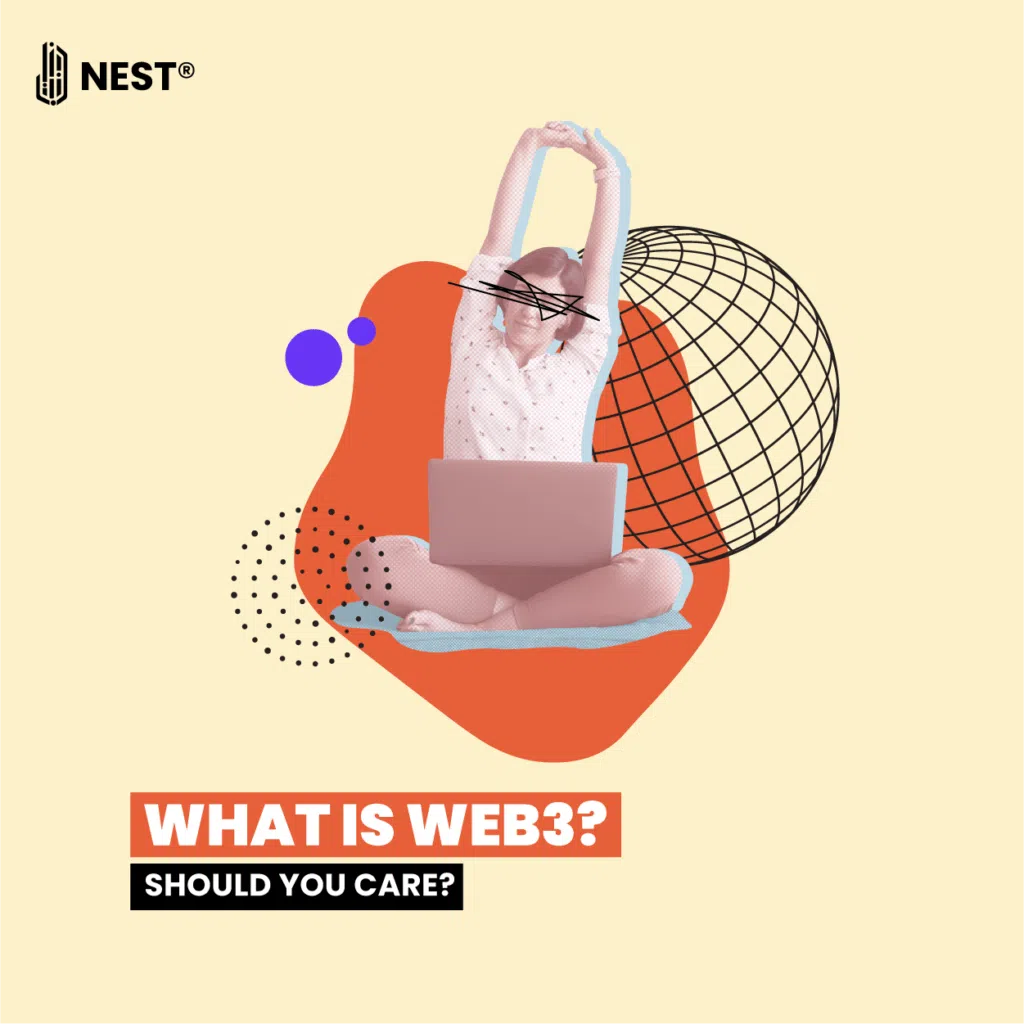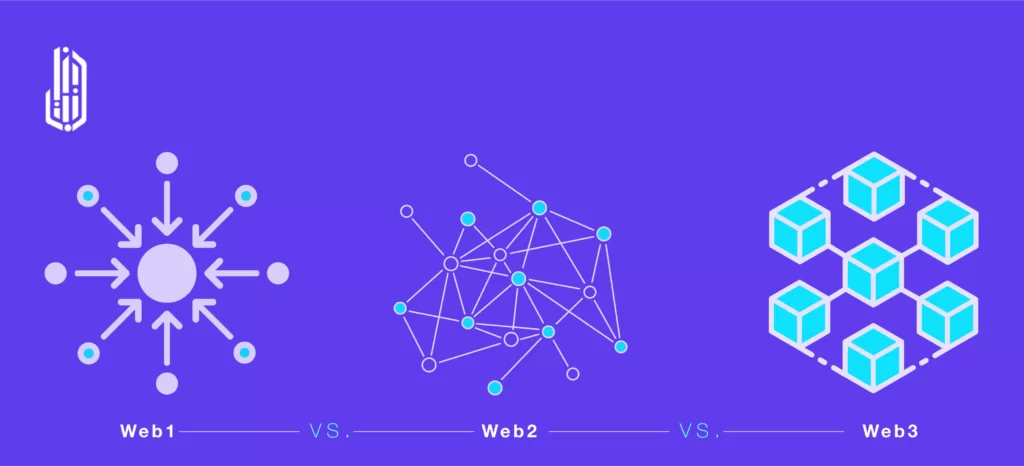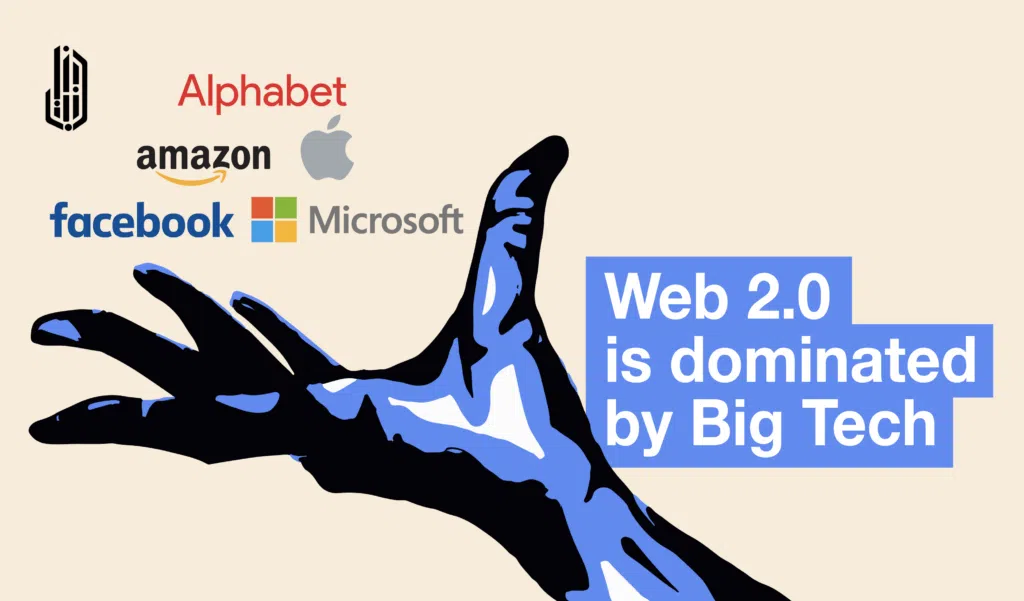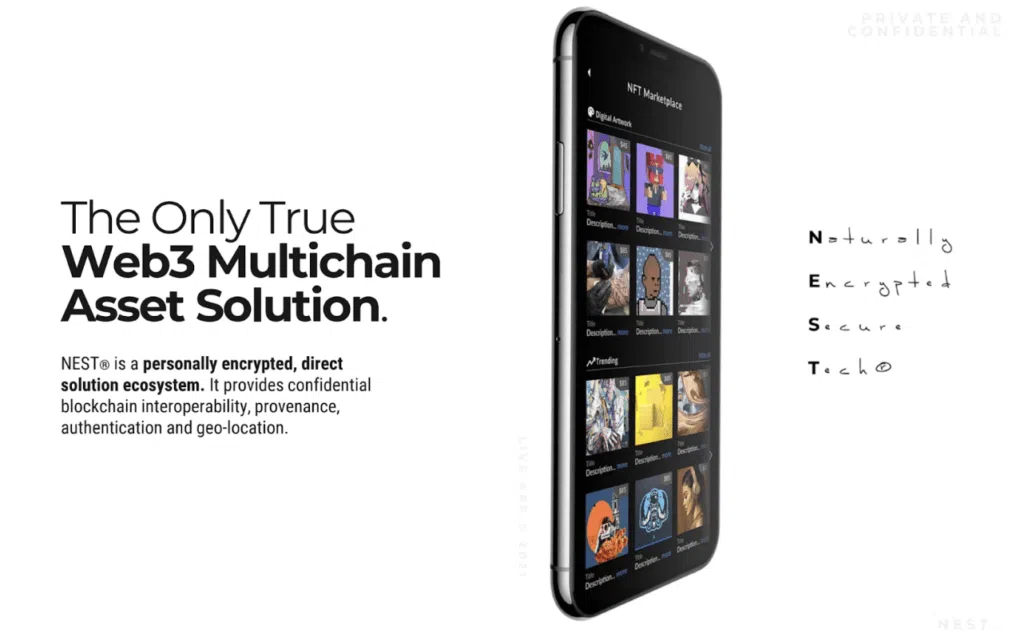
Picture this. You walk into a Bored Ape-themed restaurant and pay for a combo meal using $APE coins. While waiting for the meal, you sell your old game armor to a noob in return for some crypto and attend a virtual meeting as a raccoon.
If this sounds like a routine straight out of a Sci-Fi novel, it’s not. This could be what your day looks like when Web3
is finally here. The term obviously refers to the third potential iteration of the internet, and you’ve probably heard of it. But is it just a passing fad, or does the future really hold some exciting opportunities? NEST®, the first blockchain digital identity solution of its kind, weighs in.
The evolution of the internet

To start understanding why you should care about Web3, let’s step back to the beginning of the internet and the events that prompted the need for a new version. When the internet began in 1989, it was fully decentralized: regular computers acted as servers. Developers could build new software on top of the existing ones, and users could switch between different platforms easily.
In other words, if Facebook existed back then, you could modify its code to build a better social media platform or even send messages to someone on Twitter using the Messenger app. But the only flip side was that you needed technical know-how to post something on that version of your ‘Facebook’ wall or ‘Instagram’. So, Web 1.0 was read-only, meaning only a few users could publish content online, and the rest consumed content. But this changed when Web 2.0 came along in 2005.
Web 2.0: Centralized Social Web

Web 2.0, also known as the social web, created an ecosystem that allowed users to engage with content online as well as post content to their websites and social media profiles. The paradigm shift from “read-only” to “read and write” led to a massive rise in the popularity of Web 2.0 and Web 1.0 slowly morphed into the internet we know today.
But the most important drawback that led to the call for Web 3.0 was centralization. Unlike Web 1.0, where anyone could host a server with their computer, Web 2.0 is dominated by centralized services alongside the four tech companies – Google, Apple, Facebook and Amazon (GAFA).
43% of the world’s traffic flows through these platforms, and Google controls almost 87% of it when it comes to global search.
How did this centralization happen?
In the Web 1.0 days, people didn’t use their credit cards for making online purchases. So, the best way to make money from visitors was to offer free content and run or serve them ads online. Over time, the ad revenue model became the web’s default business model, and companies realized that ‘data was the new oil’.
But Web 1.0’s standardization proved to be a serious roadblock to their plans, as it meant users could transfer their content to a more advanced or secure platform. So, companies adopted internal standards to anchor users to their platform and continue monetizing their data. This unbridled data collection paved the way for large, centralized data centers, which themselves are also vulnerable to cyberattacks. Because it’s a centralized target, kind of like a bank or form of a single point repository.
The most notable attacks include Facebook’s 2021 data leak, which exposed 500 million+ users’ personal information and the company’s infamous Cambridge Analytica scandal. Google+ also faced a similar breach in 2018 that exposed 52.5 million users’ data to the world.
Unfortunately, the accounting of breaches doesn’t end there, as companies aren’t the only data hoarders. Several governments have also been accused of using data to create global surveillance programs to track their citizens. So, Web 2.0 became synonymous with data tracking, security breaches, and hyper-centralization, which has led to the call for the internet’s decentralization.
The Web 3.0 Revolution: Transitioning To A Decentralized Web

Web 3.0 is the new iteration or re-wiring of the internet. It aims to re-enable connectivity and engagement into its naturally decentralized state. It ideally is trustless, meaning there is no one central authority or entity inherently required to act as an intermediary, to make the network function. So when this is enacted correctly, in Web3, you won’t need your bank to make a transaction and you won’t have to pay a bank or provider their annual credit card fee for handling your transactions.
Also, in Web3 there is no authority that can objectively decide which user can access applications or services. So, for example, your regional government cannot decide which website or application you can or can’t use, or which transactions you can or can’t perform. In other words, it is possible that Web3 enables a permissionless ecosystem. That still doesn’t make it any clearer.
So, what exactly is Web3?
Before we answer what Web3 is, let’s talk about what Web3 isn’t. The opinions typically stand divided on the topic. Web3 is not a tacky buzzword that refers to building solutions for problems that don’t exist. It isn’t a venture capital ploy to make Web3 the next big thing and collect even more data from consumers.
It’s the opposite. Web3 aims to reposition power away from centralized corporations that hold a monopoly over the online services and distribute it directly to the users. It is the users who now can have complete, confidential control and ownership of their data, transactions and choices.
That’s not all. Web3’s proponents see this as a method to repair what’s broken in our current economy. They hold that this rewiring will deliver better methods for everyone from developers and artists to actually benefit from their work. It can also help organizations find better ways to pool resources and collect funds.
Does this mean new Web3 economies can eliminate the corporation? No. Web3 simply aims to put consumers in the driving seat and have more control over their data and digital assets. So, large corporations will continue operating the Web2 and Web3 space, but they will most likely be forced to now increasingly facilitate user experience, instead of dictating it.
For instance, social media platforms like Facebook, Instagram and Twitter could possibly exist on Web in a very similar form. But when correctly enacted, they couldn’t profit from user data or really own any content their users post online in the same way that they do today. In other words, users in Web3 have the potential to run their internet, exchanges, services and functions. This is instead of them relying on large corporations or even governments. Sounds fascinating, doesn’t it?
Web3 Technologies That Solve “Real” Problems

Right now, the whole idea of Web3 can sound somewhat like a utopian fantasy, written by proponents of blockchain. Yet there are a few technologies fueling Web3 transitions that are already gaining significant traction.
Decentralized Autonomous Organizations (DAOs)
DAOs are online member communities that the members themselves run. Each member has a (tokenized) vote. They’re similar to say Reddit communities with a dash of decisional democracy. The entry to the community is token-based, and every time a decision has to be made, a member submits a proposal, and everyone in the community gets to share their opinion through votes.
So, if you’re a charity, you could build a DAO that accepts donations from any part of the world, and its members then get to decide how they want to spend those received donations. As a result, members are logically more directly vested in the cause and more proactive in say, donating or participating throughout the community.
Decentralized Finance (DeFi)
Can you imagine a world where there are no extensive or invasive applications to fill or tedious individual accounts to open, just so that you can then conduct your ‘authorized’ transactions online? Well, Decentralized Finance or DeFi has the potential to make this possible. DeFi is an emerging set of technology and protocols that further aims to eliminate the Web2 or centralized needs of third party financial institutions. The cutting out of the middlemen in financial transactions, without any degradation to trust or security.
DeFi has the potential to replace many, if not all, current banking systems. Further, they bring the capacity for safer alternatives that give better interest on products like insurance, investments, transactions and savings. From this, the lending landscape is also changing. Rather than applying for a loan from a centralized banks, Web3 participants can take a digitized loan, in multiple currency formats, directly from individuals or communities. The immutable ledgers, blockchain, permit the trusted extension of these accounts while smart-contracts, agreements, allow their unbiased execution.
Blockchain + Video Games
The Web3 revolution is also making its way into the gaming industry. Multiple tier1 developers as well as gaming startups have already popped up in the space to deliver a different game-play experience. Here’s what Alex Shalesh, a Web3 gaming startup founder said:
–
“We are enabling technology that brings games away from the centralized publishing platforms, or centralized publishers that own those great brands, closer to the players themselves. We believe that ultimately, the value of the games will be much more concentrated within the hands of gamers, because they are the ones who are in a way responsible for the success of those games.”
–
What Alex means is that, unlike traditional games, ones developed on blockchain technology can offer players a kind of personalized economy. This is a space where they themselves can have ownership over their engagement and across to things like their in-game items. This ownership capacity has the potential to broaden engagement with a second layer of flexibility, as players’ may also hold abilities to transfer their in-game items to other networks and games.
So, for example, if a player purchases an NFT and gains ownership of a skin, avatar, tools, or experience points they can then sell or transfer these in a gaming environment or to external marketplaces. There are multiple detailed considerations of IP right ascriptions, digital asset controls and forms of authorized contractual exchange across this space that are exciting both players and developers alike.
And if you’re a creator, you don’t have to depend on centralized services like YouTube ads for monetization. Web3 gaming and engagement infrastructures have the potential to directly fuel the creator economy. User-led terms and structures of this monetization extends into every facet of the lifecycle – from payroll, rewards across to persistent benefits for game creators and beyond.
Non-Fungible Tokens (NFTs)
The most immediate and commonly understood example of NFTs’ power today is if you’re an artist or creator. With such unique or tangible content, even broadly accessible Web3 tools can today immediately allow artists and creators to both exercise a certain form of uncensored freedom of expression as well as a way to create a more secured form of asset from this content which is able to be monetized to a global market.
For example, artists have the ability to set persistent royalties for their NFT assets which can guarantee that a certain percentage of all future sales are paid to them directly. With persistent royalties, should the price of that artwork rise over time, the creating artist always receives a commission or ‘cut’ of this – no matter when or between whom this is sold. This has the ability to remove the gallery profiteering structure and ensure persistent profitability for the creator. For instance, if the persistent royalty commission rate is set at 10%, when an artist initially sells their work for $10,000 – they receive that asking price. Later, if the same artwork is sold by the original buyer for $200,000, at the time of their sale that original artist still receives $20,000 as a secondary payment, this being their 10% royalty fee. This can repeat ad-infinitum.
And if you’re a buyer or a collector, with NFTs you have the direct capacity to support the artists or creators. Plus, you get to set your NFTs as profile pictures and flex your collection online. Yes, it’s kind of similar to flexing your Pokemon card collection in some ways but – we won’t judge.
If Web3 Has So Many Benefits, Why Isn’t It HERE yet?

Web 3.0 is still in its infancy. It needs significant efforts if users are truly going to realize the vision of authentic decentralization. With that being said, here are some of the major challenges that the Web 3.0 ecosystem faces today.
Proving Ownership Over Digital Assets
Chelsea art gallery owner Todd Kramer got scammed out of digital assets worth $2.2 million in December last year. And the worst part? He could recover only a few of his assets, nobody could trace the scammers. Todd’s not the only one, and he won’t be the last because these NFT heists are becoming commonplace.
So, if you think that you actually own your digital assets right now, fundamentally you’re wrong. Common smart-contracts, tools and blockchain networks cannot offer ironclad protection against theft. The tools themselves are pseudo-anonymous with multiple digital asset forms kept on open servers. This means there is ‘no one’ controlling an asset. It’s literally open for the taking. This is where NEST®’s distributed ledger technology (DLT) and individual, hyper-encrypted protocols shine. These let users create, manage, store and exchange assets with authenticated provenance and individually encrypted security. This is partially enabled through bespoke Self-Sovereign Distributed IDs (SSDIDs) For you, this means confidential real-world ownership control capabilities of digital assets.
Protecting Creators From Theft
When it comes to artwork in the digital world, a copy is as good as the original. Anyone can right-click and save your image and re-mint them as NFTs in different marketplaces. And as we already explained above, there’s no way to prove ownership over your artwork. Instead of mitigating the problem, current Web 3.0 wallets and common protocols are only adding to it as storage of master or main digital asset files are often kept in public servers, such as IPFS. Meaning anyone with internet access can download the actual master file, a perfect replica or copy of that digital asset, re-mint this on an alternate network and then sell the new NFT on as theirs or an original. NEST® enables the individual encryption and secured control of all master files, as well as the secured control of any user-selected data. This quantum-proof methodology renders them entirely inaccessible to anyone but their verified owner. There are also artificial intelligence (AI) and machine learning (ML), database confirmations to prevent copyright infringement. NEST® boasts the largest on-chain library for both traditional and digital artwork of its kind.
Remain Truly Anonymous
Pseudonyms on the internet don’t guarantee anonymity. It only took a tiny bit of sleuthing by Buzzfeed to figure out the true identities of Bored Ape creators, “Gargamel” and “Gordon Goner” even when the crypto world prides itself on anonymity.
NEST®’s Self-Sovereign Distributed IDs (SSDIDs) enable confidential and hyper-secured self-management of personal assets and data. This also means the ability for a selective disclosure of your identity or information with Zero-Knowledge Proof (ZKP) capacities. So, for example, if or when you want to prove that you’re over 18 years old to watch an R rated movie without revealing your whole identity, then you can disclose and verify only your age while not disclosing any other personal information when you’re buying a ticket. This ability has enormous implications and use-cases for all types of engagement and exchange across the Web3 ecosystem.
Fragmentation and Siloed Infrastructure
Currently, Web 3.0 is fractured. Protocols and businesses operate independently of one another. So, if you’re working on Web 3.0 right now, you typically cannot seamlessly integrate different workspaces, applications nor maintain a comprehensive and organized functional work flow.
Many users suggest that the way out is to adopt a new theoretical and forthcoming protocol, often labeled ‘the new Ethereum killer’. This is a concept. Yet instead of replication of singular dominance, centralization, the way forward is to create a cross-chain application that functions across any and all varied networks. Think of it as creating a tool that can function on any operating system instead of waiting for the operating system itself to change. Or instead of waiting for one operating system that the entire world collectively decides to use. NEST® has already solved this challenge by allowing true, confidential interoperability. Today in NEST®, you can import or swap your assets across platforms in just a few clicks from your mobile device. This extends to all types of network utilizations, transactions and exchanges – each now immediately accessible and entirely confidentially controlled by the user.
Wrapping Up
Web 3 is neither a capitalist-fed utopia nor a wild dystopia. It is the forthcoming answer ans solution to digital centralization. However, the technologies and protocols it brings are promising, albeit each come with their own sets of challenges and use-cases. So, instead of being swayed by opinions towards either end of the theoretical spectrum, it’s better to focus on practical utility and what Web3 features can do for you. If you’re ready to join the Web 3 revolution with next-gen, confidential digital asset management and real-world ownership control, follow NEST® on Twitter, Telegram and Medium. Thank you!






